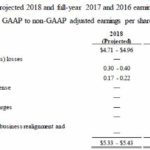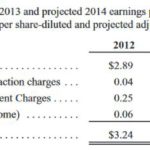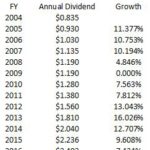Contents
 Summary
Summary
- Hershey recently released its Q4 and FY 2017 results which were not received well by the investment community. The stock has dropped ~$12 from its mid-December ~$115 level.
- HSY’s FY2017 revenue results are far short from the ambitious ‘$10B by 2017’ goal set in 2013.
- Revenue and diluted EPS in FY2017 were not that much different from 2013 levels.
- In the vast universe of companies in which I can invest, HSY is certainly nowhere near the top of my list and I will not be adding to my position.
Introduction
On February 6, 2017 I wrote a post on Hershey Company (NYSE:HSY) in which I indicated ‘boring can be sexy’. In that post I wrote the following:
‘HSY is not a company where I envision a huge run-up in the stock price. While there might be the occasional uptick every time a takeover offer comes along, I really don’t see The Hershey Trust Company, which holds the lion’s share of the voting rights, ever agreeing to sell. In essence I don’t see HSY’s stock price going through the roof any time soon.’
‘I do not view the current dividend yield as being attractive.’
‘You should probably just accept that HSY will continue to plod along. The stock price will likely continue to tick up over the long term and the dividend will increase consistently over time. That is probably the most you can expect but sometimes, “boring” can be “sexy”….especially when markets correct.’
I also pointed out that:
Some investors were disappointed the Mondelez International Inc. (NYSE: MDLZ) offer for HSY in 2016 for $107/share ($23B in total) was not accepted. I noted that with the retirement announcement of HSY’s CEO, effective the end of February 2017, there was cautious optimism another takeover offer could be presented subsequent to his departure.
My take was that the likelihood of another takeover offer being successful was unlikely given the incoming President and CEO had been HSY’s EVP and COO for the past 11 years.
That certainly was not a glowing endorsement of the company even though I was approaching my analysis from the perspective that we had purchased HSY years ago at an average cost of $47.43.
I can’t even find my investment statements prior to 2005 but I know we owned HSY shares at the beginning of 2005 (fortunately they are owned in a retirement account so the average cost is a non-issue from a tax perspective). Since we have continually automatically reinvested our dividends to acquire new HSY shares and our average cost is as reflected above, I suspect the shares were acquired in 2004.
Now that HSY has released its Q4 and FY2018 results on February 1, 2018, I thought I would take a look at how things have transpired subsequent to that post.
Current CEO’s March 4, 2013 Interview in Forbes Magazine
Before I delve into the current results I thought I would do a bit of digging on the current CEO and President’s (Michelle Buck) history with HSY.
I uncovered an article in the March 4, 2013 edition of Forbes in which Michele Buck was interviewed; Ms. Buck had joined Hershey in 2005 as Chief Marketing Officer. By the time of the interview, Ms. Buck had become HSY’s SVP and Chief Growth Officer and HSY had posted consistent gains in sales and net income over the 2008 – 2012 timeframe.
In the interview, Ms. Buck indicated that when the former CEO took the reins he indicated HSY needed to look at the company’s next phase of growth. In order for HSY to be successful over the next 20 years he indicated the company needed a ‘growth officer’ tasked with driving the company by a ‘marketplace approach rather than a financial approach to strategy’.
Ms. Buck was tasked with looking at the marketplace, the environment, and what was going on with the consumer so as to architect the company vision for the next 20 years. Buck was instrumental in creating HSY’s game plan to achieve the $10B revenue mark by 2017, a 50% increase over the $6.6B in revenue posted in FY2012.
This extremely aggressive top-line growth rate was to be achieved through the transformation of HSY’s geographic footprint wherein 25% of revenue would be generated internationally. The game plan was to expand the portfolio, to be innovative, and to merge and acquire.
When she started laying out the aggressive vision, the game plan included making China a priority market. She stressed that China is the No. 1 market, which means it will get every dollar it needs to grow as fast as it possibly can and then everybody else will get dollars.
Let’s see how things have turned out for HSY subsequent to that interview.
Q4 and FY2017 Results
HSY’s most recent results can be found here.
When HSY released its Q4 and FY2016 results it provided its outlook for fiscal 2017 which consisted of the following:
- Continued rollout of Hershey’s Cookie Layer Crunch bars, barkTHINS chocolate and other new products such as Reese’s Crunchers candy and Krave meat bars and sticks, is expected to accelerate North America sales growth.
- International macroeconomic challenges expected to persist, especially in China.
- Full-year net sales expected to increase 2% to 3% including a net benefit from acquisitions of about 50 bps and unfavorable foreign currency exchange rates of about 25 bps.
- Reported diluted EPS expected to be $4.54 – $4.65.
- Adjusted EPS expected to increase 7% to 9% and be $4.72 – $4.81.
Actual results were $3.66 FY2017 diluted EPS and $4.76 on an adjusted basis.
Well….that didn’t work out as planned!
I’m not quite sure how Ms. Buck could kick off the February 1, 2018 conference call with analysts indicating that:
‘As I step back and review 2017, we had a solid year, making good on our strategic plan that strengthens our business model and positions the company for future growth.’
Shortly thereafter, Ms. Buck indicated:
‘We’re optimizing our in-country supply chain and streamlining the operating model as we strike the right balance between in-country investments and near-term market opportunities. As expected, China fourth quarter net sales declined about 30%, driven by volume declines related to SKU optimization and our focus on pack types that meet marketplace velocity thresholds.’
This certainly doesn’t sound like the same message Ms. Buck delivered in her interview in the March 4, 2013 edition of Forbes magazine!
Ms. Buck then goes on to say:
‘Confections is one of the largest segments within the $100B U.S. snack market, and the acquisition of Amplify broadens our participation in salty snacks, one of the fastest growing sub segments. Our strong U.S. marketplace presence and solid financial position give us the flexibility to smartly invest in confectionery and other warehouse salty snacks, as well as in the capabilities that will give us a competitive edge at retail and with consumers.’
I strongly suspect the confection segment, being one of the largest segments within the $100B U.S. snack market in 2017, is much larger than it was at the time of the 2013 interview. You would, therefore, expect HSY to have reaped some of this confection segment growth yet HSY’s total FY2018 revenue amounted to $7.515B; total revenue in FY2012 and FY2013 was $6.644B and $7.146B respectively.
These results are certainly far short from the ambitious goal of hitting $10B in revenue by FY2017!
The following shows how HSY’s FY2017 $3.66 diluted EPS and $4.76 adjusted diluted EPS compares to the same metrics for FY2012 and FY2013 and the FY2014 forecast.
 Source: HSY Q4 and FY2017 Earnings Announcement
Source: HSY Q4 and FY2017 Earnings Announcement
 Source: HSY FY2013 Annual Report – page 50 of 112
Source: HSY FY2013 Annual Report – page 50 of 112
Without the multiple adjustments, HSY’s reported – diluted EPS for FY2017 is pretty much flat relative to FY2013!
Free Cash Flow (FCF) for 2012 – 2016 was ~$0.817B, ~$0.84B, ~$0.474B, ~$0.858B, ~$0.714B. FCF for the trailing 12 months (TTM) ended September 2017 was ~$0.908B. A least FCF, what I consider to be an extremely important metric, came in relatively strong.
Long-Term Credit Ratings
Readers are cautioned that HSY’s Long-Term Debt A1 rating from Moody’s and its A rating from Standard & Poor’s, which are both ‘Upper Medium Grade’, are currently under review with negative implications!
Valuation
As recently as mid-December 2017 HSY was trading ~$115. HSY’s stock price has subsequently taken a hit and is now at the ~$103 level (February 2, 2018 close).
On the basis of FY2017’s $3.66 diluted EPS and $4.76 adjusted diluted EPS we get a ~28.1 diluted PE and a ~21.64 adjusted diluted PE.
Using the ~$103 stock price the mid-point of management’s projected diluted EPS ($4.84) and projected adjusted diluted EPS ($5.38), we get a ~21.3 forward diluted PE and a ~19.15 forward adjusted diluted PE.
In my opinion I view these levels as high for a company that just plods along. A further retracement in HSY’s stock price to the $95 level would result in a ~19.6 forward diluted PE and a ~17.6 forward adjusted diluted PE. Having said this, please read my Final Thoughts section below for my recommendation.
Dividend, Dividend Yield, and Dividend Payout Ratio
HSY’s dividend history can be found here.
On February 1, 2018, HSY announced a quarterly dividend of $0.656 on the Common Stock payable March 15, 2018 to stockholders of record February 23, 2018. This represents the 3 rd dividend payment at this level. The $2.624 annual dividend yields ~2.55% on the basis of a ~$103 stock price.
Fortunately HSY has rewarded shareholder with ~9% dividend growth since 2004 (the year in which we acquired our HSY shares). Depending on your holding period, however, your dividend growth experience could be even more pleasant or unpleasant. HSY certainly adopted a conservative dividend growth stance during the Financial Crisis!
I don’t chase dividend yield but if HSY’s stock price is unlikely to experience any significant growth I certainly expect a better dividend yield.
The current $2.624 annual dividend is ~71.7% of FY2017’s $3.66 diluted EPS and ~55.1% of the $4.76 adjusted diluted EPS.
On the basis of FY2018’s projected diluted EPS ($4.84) and projected adjusted diluted EPS ($5.38), the dividend payout ratio is ~54.2% and ~48.8%. These levels are more reasonable than the FY2017 actual levels.
HSY has two classes of stock outstanding, Common Stock and Class B Stock. Holders of the Common Stock and the Class B Stock generally vote together without regard to class on matters submitted to stockholders, including the election of directors.
Holders of the Common Stock have 1 vote per share. Holders of the Class B Stock have 10 votes per share. Holders of the Common Stock, voting separately as a class, are entitled to elect one-sixth of HSY’s Board of Directors. With respect to dividend rights, holders of the Common Stock are entitled to cash dividends 10% higher than those declared and paid on the Class B Stock.
If you own HSY shares, you most likely own the Common Stock.
In 2008, HSY had a Weighted-Average Shares Outstanding (WASO) of 60,777 million Class B shares. In 2017, WASO was reduced to 60,620 million.
In 2008, HSY had a Weighted-Average Shares Outstanding (WASO) of 228,697 million Common shares. In 2017, WASO was reduced to 213,742 million.
Final Thoughts
There is a vast universe of publicly traded companies in which you can invest and many offer far more upside than HSY. While we have owned HSY for many years and have been aptly rewarded, I think you will be challenged to generate a decent return if you invest in HSY at current levels (even with the recent pullback).
Here was a company in 2013 with ambitious plans to hit the $10B revenue mark by 2017. I recognize ‘revenue is vanity, profits are sanity, and cash flow is reality’ but given that FY2017 revenue and profits are not that materially different from 2013 levels (relative to the growth experienced by many other companies), I wonder how many more years it will take HSY to ‘breakout’ and reach that $10B revenue target.
I am not about to sell our currently held HSY shares but at the same time I am not prepared to add to our position.
If you intend to initiate a position in HSY at current levels, be forewarned….don’t expect outsized returns.
Note: Thanks for reading this article. Please send any feedback, corrections, or questions to charles@financialfreedomisajourney.com.
Disclaimer: I have no knowledge of your individual circumstances and am not providing individualized advice or recommendations. I encourage you not to make any investment decision without conducting your own research and due diligence. You should also consult your financial advisor about your specific situation.
Disclosure: I am long HSY.
I wrote this article myself and it expresses my own opinions. I am not receiving compensation for it and have no business relationship with any company whose stock is mentioned in this article.


